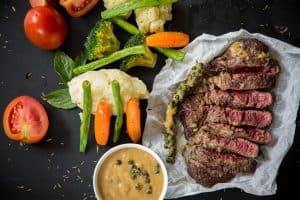The ketogenic or “keto” diet is one of the most popular diets in the world. I also consider it to be one of the most effective tools I used to clear up my acne breakouts over 5 years ago.
Most people who have heard of “keto” typically think it’s a weight loss diet, but keto can also have some pretty huge health benefits when it comes to your skin. Although most substantial diet changes can cause an inflammation spike in the short term, the ketogenic diet is great for reducing inflammtion long term. This includes reducing skin inflammation like acne breakouts.
Many people see your typically keto diet filled with butter, tons of meat, and oils by the gallon and think, “there’s no way that can be healthy for my skin”, but the truth is, if you do the keto diet right, it can be a huge asset for eliminating acne.
On the flip side, there are also a lot of potential pitfalls when it comes to keto and your skin, including an increased risk of fungal acne and dermatitis on high-fat diets.
In this article, we’ll cover both the good and the bad of keto when it comes to acne, and how you can create the ultimate low-carb diet for clear skin.
How Does The Ketogenic Diet Reduce Acne Breakouts?
Acne breakouts occur when sebum oil and dead skin cells are mixed together and clog the pores. Typically this happens when your body is producing too much sebum oil. One of the main reasons the body produces too much sebeum oil is because of hormonal changes when consuming carbs, sugar, and processed foods. When you foods that are high in sugar or carbohyrdates the insulin spike sends a signal to your sebaceous glands to produce more oil.
Fortunately, keto fixes this problem for most people. The ketogenic diet significantly cuts the amount of carbs and sugar most people consume on a daily basis. For most people this is a drastic dietary change, which can cause short term inflammation as your body adjusts to a fat dominated diet. This short term inflammation can cause aching, diarrhea, and even acne breakouts. Typically, these symptoms are mild however, if you begin having severe discomfort you should immediately call your doctor. Most people get over these initial symptoms after the first 1-2 weeks of following the ketogenic diet. After the initial shock to your system you should notice a substanial difference in several areas within two weeks of starting the ketogenic diet. Many people can see a significant difference in the ckarity of their skin, improved sleep, faster recovery, weight loss, and improved energy
What is the Ketogenic Diet?
This is not going to be a comprehensive guide to everything there is to know about keto – the main focus of this article is going to be on keto and acne.
Still, in case you’re unfamiliar, I’ll provide some of the fundamentals of the keto diet here.
A “keto” diet describes a way of eating in which your body burns ketones (fat) for fuel. Hence, why it’s called the “ketogenic” diet.
The vast majority of people do not burn ketones/fat for energy, at least on a regular basis. Instead, they burn glycogen and glucose found in carbohydrates.
The basic process for most people looks like this…
- You eat carbohydrate-rich foods
- All the carbohydrates are converted into sugar (glucose) in the bloodstream
- The rise in blood sugar causes the pancreas to release a hormone called insulin which converts the sugar (glucose) into usable energy (glycogen)
For some people, this process goes on without any problems.
But for upwards of 1 out of every 3 American adults1https://www.niddk.nih.gov/health-information/diabetes/overview/what-is-diabetes/prediabetes-insulin-resistance this process does not function properly due to something called insulin resistance.
Insulin resistance is a situation in which the body releases several times more insulin than it needs every time you eat carbs, leading to massive energy crashes, weight gain, acne breakotus, and hunger spikes.
Insulin resistance can take place for a whole host of reasons – genetic factors, overconsumption of carbs, and lack of exercise, just to name a few – but what’s important for our discussion is to note that insulin is a nightmare for acne.
But, let’s take a step back. If most people burn carbs for fuel, how is the ketogenic diet different?
Ketosis flips this whole process around, instead of burning carbs for energy, your body burns fat by converting fatty acids into ketones. Believe it or not, this process is actually a lot more efficient than burning carbs for energy. Think about it, do you think our ancestors were running around all hopped-up on Hot Pockets and Jolly Ranchers? Nope, they were likely in a state of ketosis most of the time.
Alright, so let’s quickly cover what the ketogenic diet looks like in practical terms…
What Can You Eat On Keto
To get into “ketosis”, where your body is burning fat for fuel, it’s pretty simple – limit consumption of carbs and increase consumption of fats.
In the absence of carbs, the body has no option but to burn fat for fuel, and unlike carbohydrates, fat does not trigger an insulin response from the body.
Thus, a typical ketogenic diet adheres to the following “macros”:
- High in fat (~60-70% of calories)
- Moderate in protein (~20-25% of calories)
- Low in carbs (~5-10% of calories, or <20g net carbs/day [a net carb is total carbs – fiber])
Most people will track calories for a few days using an app like Cronometer to get a baseline for their carb consumption.
Typical “keto-friendly” foods include:
- Meat (and lots of it): Beef, lamb, pork, poultry, turkey, etc.
- Fish & Seafood: Salmon, sardines, trout, shrimp, shellfish, oysters
- Eggs
- Whole fat dairy
- Leafy Vegetables: Spinach, romaine, broccoli, kale, cauliflower
- Saturated fats: Coconut oil, butter, olive oil
- Nuts: almonds, macadamia, pecans
- Avocados, olives
- Small amounts of low-sugar fruit: Blackberries, blueberries, strawberries
Typical foods to avoid on keto include:
- Grains: Wheat, barley rye, corn, rice, quinoa
- Legumes: Beans, soy
- Most fruits: Apples, bananas, oranges, fruit juice
- Starchy vegetables: Potatoes, sweet potatoes, corn
- Sugars: Honey, syrup, high-fructose corn syrup
- Low-fat dairy: Skim milk, fat-free or low-fat yogurt
- Most Alcohol: Beer, sweet wines, mixers
- Non-diet Soda/Soft-Drinks
- Processed foods with hidden carbs
Again, I’m not going to go into full depth here on all the foods to enjoy and avoid for keto, but as a whole, if you keep net carbs to less than 20g per day, you’ll be in ketosis.
So, let’s now turn to the single largest benefit of the keto diet for acne: a massive reduction in the production of an acne-causing hormone, insulin.
How Carbs, Insulin, & Hormones Effect Acne
A lot of people like to focus on sex hormones, like DHT, estrogen, or testosterone when it comes to acne, but the real root cause of most adult hormonal acne isn’t sex hormones, but DHT.
The reason for this is simple: insulin triggers a cascade of other acne-causing hormones and compounds that damage the skin and make your face the perfect breeding ground for acne.
When the body releases insulin, it also releases two hormones, insulin-like growth factor-1 (IGF-1) and insulin-like growth factor-binding protein 3 (IGFBP-3) and a compound called IL-1.
In my book, Unmasking Acne, I discuss why on a biological level these are a nightmare for acne…
These insulin-like hormones are all directly related to the physiological process of acne forming on the surface of the skin:
- IGF-1 and IGFBP-3 blocks pores
- IGF-1 increases oil production
- IL-1 and IGF-1 promotes inflammation
Physiologically, insulin not only makes your skin more susceptible to acne bacteria infections by clogging pores and increasing oil production, but it also makes sure that when that infection takes place it turns into a bright, red, protruding comedone, or a pimple.
Again, I reference a rather interesting study to really bring this point home…
As you can see, insulin, and the hormones that accompany insulin, contribute to all three of the root causes of acne, which is why there is no surprise that one study found that fasting insulin levels (a good marker of insulin resistance) were over 50% higher in patients with severe acne when compared to individuals without acne[i].
[i] EmiroÄŸlu, N., Cengiz, F. P., & Kemeriz, F. (2015). Insulin resistance in severe acne vulgaris. Advances in Dermatology and Allergology, 4(4), 281, 285. https://doi.org/10.5114/pdia.2015.53047/
That’s right, one of the single largest indicators of whether or not someone has acne was their fasting insulin levels.
Remember that study I referenced earlier, where upwards of 1 in 3 adults suffer from insulin resistance, a condition in which the body overproduces insulin?
Well, it’s no surprise that nearly half of all adults continue to struggle with acne.
Now, let’s get to the fun stuff – how does keto affect insulin, and in turn, acne?
Why Keto Can Be Great For Acne
Many people experience pretty profound changes in their skin when transitioning to keto simply because of the reduction in insulin.
Again, this is a topic I cover in detail in my book:
One comprehensive study on the effects of the ketogenic diet found that insulin resistance dropped by upwards of 75% after just two weeks of eating a low-carb diet.
Keto not only reduces insulin spikes which trigger hormonal acne, but it also reduces inflammation. Add in some gut-friendly and easily digestible foods, and you have yourself a diet that combats all three root causes of acne. It really is one of the most powerful and useful diets out there for fighting acne.
Right off the bat, keto powerfully blunts two of the major root causes of acne:
- Insulin and its accompanying hormones/compounds that increase oil production and clog pores
- Inflammation that contributes to the visual appearance of pimples and acne
This isn’t surprising – in fact, one of the best studies we have regarding diet and acne showed that a low glycemic index diet (a diet that is relatively close to a ketogenic diet) showed significant improvements in acne over the control group in just 12 weeks2https://pubmed.ncbi.nlm.nih.gov/17616769/.
Overall, cutting back on carbs and going keto is one of the single best resources you can use to reduce both hormonal and inflammatory acne, but only if you do the ketogenic diet right.
There are a ton of common pitfalls that people fall into when it comes to keto, and it makes them considerably more likely to get acne.
11 Mistakes to Avoid on Keto for Acne
The key thing to note here is that you’ve already done the hard part: eliminating most carb sources.
Carbs trigger the release of insulin, a hormone largely responsible for acne. Just by going keto, you’ve made a great first step in eliminating acne, but you’re not quite there yet.
These tips are hopefully all you need to beat the last of your acne with the ketogenic diet.
1. Avoid Dairy
Despite being low in carbohydrates and technically keto-friendly, dairy is arguably the single most problematic food group when it comes to acne.
Related: Why (most) dairy causes acne
Dairy contains large amounts of hormones, including insulin, IGF-1, and IGFBP-3, that trigger the body to produce excess skin cells and sebum oil that can clog pores. In addition to being loaded with insulin-like hormones, dairy actually produces a large insulin spike in the body despite not having many carbs (remember, insulin is the master hormone behind acne). A cup of milk produces a higher insulin spike than white bread. Yikes.

Not only does dairy cause hormonal acne, but it can damage your gut and cause inflammation too. Intolerance to lactose, the sugar in dairy, is extremely common, affecting more than half the world population. Lactose intolerance can be a driver in chronic inflammation, the process largely responsible for inflamed pimples. On top of that, the body also has a difficult time digesting dairy protein (casein and whey). In some individuals, they may even permeate the intestinal lining and lead to leaky gut syndrome.
For these reasons, cutting out dairy is crucial for clear skin. Unfortunately, when people go keto they oftentimes load up on dairy in place of other nutritious foods. Some people may find that they can tolerate raw, grass-fed, organic dairy, but you’ll never know if it’s behind your acne until you try cutting it out first.
2. Biotin and Riboflavin Deficiency
Both biotin and riboflavin are nutrients that are involved in fat transport. They help your body store and use fat for energy. The more fat you consume, the more biotin and riboflavin your body requires. Because ketogenic diets are naturally high in fats, this means the requirement for biotin increases.
Without biotin and riboflavin, the skin cannot receive the lipids it needs to be properly protected and healthy, leading to cracked, red, dry, flakey skin. This is the perfect breeding ground for fungi and yeast overgrowth that can lead to fungal acne.
Biotin and riboflavin deficiency is why a lot of folks who struggle with acne even after switching to a ketogenic or carnivore diet also experience yeast/fungal-related issues, including psoriasis, eczema, dandruff, and dermatitis.
In Unmasking Acne, I have a whole protocol for eliminating fungal acne, but the key thing to remember when it comes to keto is to consume biotin and riboflavin-rich foods, like egg yolks (not the whites, they prevent the body from absorbing biotin), salmon, or organ meats.
If you can’t consume these foods at least once a week, consider supplementing with 100mg of biotin and riboflavin daily.
3. Overconsumption of Egg (Whites)
While egg yolks are an acne-fighting superfood, egg whites are one of the worst foods you could eat for acne.
In addition to binding to biotin and preventing your body from absorbing it, they are also extremely common gut irritants, triggering an immune response from the body that leads to inflammation and acne.
On a biological level, egg whites are meant to protect the yolk and thus contain many compounds that are relatively difficult to digest. For this reason, avoid eating too many egg whites, which a common mistake people fall into when switching to keto.
4. Stress
“You mean I have worry about when I can eat too?”
- Damages skin protein which leads to weak skin
- Slows healing of existing acne and acne scars
- Decreases the number of healthy bacteria in your gut
- Dehydration, dry skin, and hair loss

5. Low-quality meat high in omega-6 fatty acids
On a diet where meat is a staple at just about every meal, it’s easy to consume boatloads of low-quality meat. While it might seem extreme to only consume high-quality meat, there are tons of good reasons for it:
- Grass-fed beef contains up to 5 times more omega-3 fatty acids (healthy, anti-inflammatory fats) than grain-fed beef
- Farmed salmon has nearly 6 times more omega-6 fatty acids (unhealthy, inflammatory fats) than wild-caught salmon
- Free-range eggs have significantly more healthy omega-3s, vitamin E, and vitamin A than caged eggs
If you can’t afford these options it’s not the worst thing in the world, but if you can I’d definitely recommend purchasing higher-quality meat, it can make a pretty huge difference in your skin.

Here’s the quick-and-dirty guide to buying acne-friendly meat:
- Beef: Organic, grass-fed
- Chicken: Organic, free-range
- Pork: Organic, pasture-raised
- Seafood: Wild-caught (this is a MUST, as farmed seafood contains extremely high amounts of inflammation-causing omega-6 fatty acids)
- Eggs: Organic from free-range/cage-free chickens
6. You’re “detoxing” or adapting
“Detoxing” is one of those new-age health words that I really don’t like – it has a pseudo-scientific aura around it that takes away its credibility.
With that being said, one common argument for acne on keto is that your body is removing and filtering out toxins stored in fat.
This hypothetically makes sense. Toxins are generally stored in fat, so when you begin to break down your own fat (instead of fat from food) for energy, you’re bound to release toxins as well. Whether or not these “toxins” can create acne is unproven.

What is more likely the case, in my humble opinion, is that adaptation to the keto diet, which takes weeks and sometimes even months, can create stress on the body (and mind) which in-turn creates acne.
If you’ve been running off carbs/glucose for the vast majority of your life and all of a sudden you decide to change it up and burn fat for fuel, your body is going to need time and resources to adapt.
Transitioning from being a carb-burner to a fat-burner can take weeks, sometimes even months.
7. Poor Sleep on Ketogenic Diets
This was a big contributor to my post-keto acne.
A lot of people experience poor sleep when transitioning to a ketogenic diet. It’s worth noting that many people experience much better sleep too.
Personally, I found myself waking up dozens of times per night when first becoming fat adapted. I thought it would subside, but it lingered on no matter what.

Using magnesium at night helped considerably, as did intermittent fasting, but my sleep was still considerably worse than when I was on a lower-carb Paleo diet (~50g net carbs per day).
If you’re still struggling, you can try having a very small amount of raw honey before bed or consuming low-sugar fruits (blackberries, raspberries, strawberries, blueberries) with your last meal of the day. As a last resort, you could also try carb-cycling and utilize a cyclical ketogenic diet, where once a week you consume around 150g of net carbs.
8. Eating Too Many Nuts On A Ketogenic Diet
Nuts can seem like a no-brainer on keto. They’re (generally) low in carbs, have adequate amounts of protein, and are extremely filling.
The problem with nuts is that most of them contain either high amounts of inflammation-causing omega-6 fatty acids or too much phytic acid, an antinutrient that prevents the absorption of several minerals, including zinc and magnesium.
That being said, nuts have some redeeming qualities too. Many nuts are high in antioxidants, magnesium, fiber, and gut-healing prebiotics, not to mention they taste great.

Not all nuts are created equal when it comes to acne. I’d recommend reading my in-depth article on nuts and acne here.
The key with most nuts is moderation. Use them as a snack, and treat them almost like you would a supplement and you shouldn’t run into any issues.
The notable exception to this rule for keto-friendly nuts is macadamia nuts, which have very little phytic acid and very little omega-6 fatty acids. While I still wouldn’t recommend eating a whole bag at once (I’m guilty of this on several occasions), macadamias are about the best nut you could eat for acne.
9. Eating the Wrong Fats on a Ketogenic Diet
Hmm, ranch sauce has pretty much no carbs, which makes it keto-friendly. That means it shouldn’t be a problem for my skin, right?
Wrong. Not all fats and oils are created equal, and when it comes to acne, most vegetable oils (soybean, corn, sunflower) beside and the products that contain them (salad dressings, artificial fats, packaged/artificial snacks) are one of the worst foods you could eat.

Vegetable oils are loaded with omega-6 fatty acids that can lead to chronic inflammation. These fats and oils trigger an inflammatory response from the immune system, which can lead to angry, red pimples.
Butter that isn’t organic and grass-fed can also be problematic due to the high concentrations of hormones. The same goes for non-grass-fed beef tallow and non-pasture-raised lard.
Instead of vegetable oils, go with healthy fats, like extra-virgin olive oil, coconut oil, grass-fed ghee butter, grass-fed beef tallow, and avocado oil.
10. Thyroid-Related Acne On Keto
The thyroid helps regulate your metabolism, body temperature, mood, and immune system. An improperly functioning thyroid can lead to a multitude of symptoms, including acne:
- Anxiety
- Hair loss
- Dizziness
- Fatigue
- Feeling too hot or too cold
- Dry skin
- Pale skin
- Weakness
The ketogenic diet has been shown to decrease the amount of T3 thyroid hormone produced, which can lead to a condition called hypothyroid. When most people go keto they also naturally consume fewer calories – calorie restriction is problematic for the thyroid as well and can lead to hypothyroidism.

I personally experienced symptoms of hypothyroidism after going full-blown keto with intermittent fasting. What was the fix?
More safe carbs. If you want to stick to keto and you’re experiencing thyroid problems, try having a once a week carb re-feed where you consume ~150g of net carbs. Alternatively, you could go with a low-carb but not ketogenic diet. That’s what I did, and quite frankly I actually felt better doing a low-carb diet than when I was on keto. I stuck to safe starches like sweet potatoes and plantains, and would just consume ~50g of net carbs per day instead of ~20g.
11. Give It More Time
To become truly fat-adapted is going to take weeks, if not months.
When you go keto, even after previously being on a low-carb diet, it’s a pretty big change for your body to adapt to. It’s going to take time to see results.

Stressing out about not seeing the results you want within the first few weeks is just going to make things worse.
It takes upwards of 30-60 days for skin cells to die off, shed, and new ones to reach the surface. That’s just one cycle. If you have existing acne and just switched to keto, it’s going to take a little while to see results. It may even get worse before it gets better. But if you follow these tips and stick with them, I can guarantee you that you’ll see some pretty profound results.
Bonus tip: Intermittent Fasting
While most people will find the ketogenic diet to be sufficient for fighting acne, others may find that even after months they’re still experiencing breakouts or not seeing the results they’d like.
In this case, one thing you could try is intermittent fasting (or potentially other acne-special diets), where you shorten the period of time throughout the day you eat. It can be as simple as skipping breakfast.
The benefits of intermittent fasting are huge:
- Lower inflammation
- Autophagy (recycling of old cells)
- Increased insulin sensitivity
- Increased oxidative stress resistance
In my book, Unmasking Acne, I wrote a whole guide to intermittent and prolonged fasting for acne.
I would not recommend intermittent fasting to anyone who recently switched to the ketogenic diet. Just going keto is a big shift for your body to go through, adding intermittent fasting can make it even more extreme. However, if you’ve been on keto for a while and want to take it to the next level, I’d highly recommend intermittent fasting as a great next step.
Frequently Asked Questions
Starting any new diet creates hormonal & metabolic changes that can trigger short-term inflammation like acne. However, over a long period of time, a ketogenic diet consisting of healthy fats and no sugar should reduce acne breakouts.
Only around 5% of your total calories should come from carbs on a ketogenic diet. Around ~75% of your total calories should come from fat and the other ~20% from protein. If you are considering a ketogenic diet make sure to talk to your doctor.


Even on dirty and lazy keto my acne goes away. It’s just the high-glycemic carbs like bread and rice who cause it for me. Especially bread is highly inflammatory overall.
Thanks for this! I’ve never had any sort of acne until starting the keto diet, and I just could not figure it out. Dairy is about 85% of it, so I am using the other tips here to hopefully get rid of it for good.